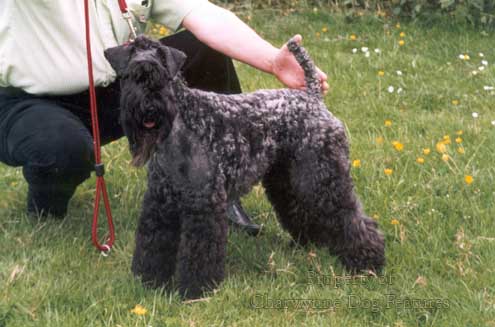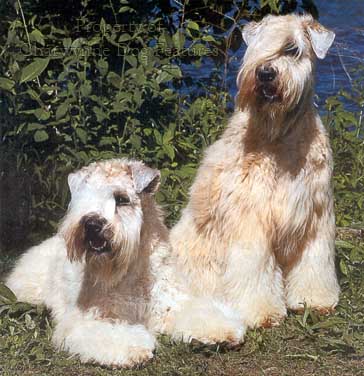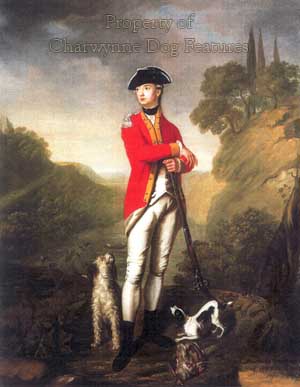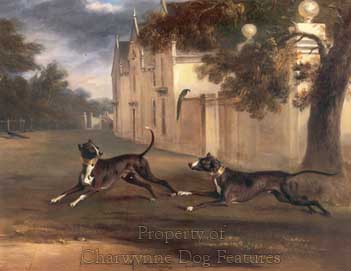469 Irish Terriers
TERRIERS IN IRELAND
by David Hancock
 'An Irish Terrier I was called And sent on bench to show,
'An Irish Terrier I was called And sent on bench to show,
But oh! how little they believed I should cause such a row. ‘
Those words from The Livestock Journal of 1876 convey at once the fellishness of 'Erin's Dare-devils', as terriers from Ireland have been named. The red-golden coated Irish Terrier, the slate-blue coloured Kerry Blue, the soft-coated Wheaten Terrier and the harsher-coated Glen of Imaal Terrier have never been accused of lacking spirit. The wheaten hue is a common terrier colouration, being found in the Border, Lakeland, Norfolk, Norwich, Cairn and Scottish Terrier breeds, as well as the terriers from Ireland. I have never liked the breed title: Soft-coated Wheaten Terrier; no breed should be identified just by the texture or colour of its coat and there are plenty of wheaten terriers. Such a distinctive and admirable breed deserves a much more precise breed title.
When working in Ireland it was always of interest to study the farm dogs there; so many of them, ungroomed and unclipped, resembled the bouviers of Belgium, the Dutch Terrier or Smoushond and the stable dogs of Germany, the schnauzers. Going to work in Germany, immediately after working in Ireland, allowed me to keep a picture of Irish farm dogs in my mind when viewing their equivalents on mainland Europe. I have seen both schnauzers and wheaten terriers being used as herding dogs in their native countries and appearing interchangeable in form and technique. Once, at a world dog show I was convinced that the Bouvier des Flandres before me was a large Soft-coated Wheaten Terrier from Ireland. Size apart, the appearance, the coat, the personality and the attitude were easily confused. I see similarities too between the Kerry Blue and the Laekenois of Belgium and the Schnauzer; perhaps the farm function deciding form. 
Two hundred years ago a litter of terrier pups in Ireland could contain coat colours ranging from black and grey, red and tan to silver and gold, wheaten and white. At the first show, in Dublin in 1874, featuring Irish Terriers, one winner was white, another black and tan and another grizzled blue. Selective breeding based on breeder and locality preferences concentrated the colour genes of terriers in Ireland into distinct groups which were perpetuated. Breeds reflected those preferences. Dr Carey, first president of the Irish Terrier Club, wrote in 1879, on colour: "Red yellow, wheaten or light brown inclining to grey. The best colour is orange tipped with red, the head slightly darker than the body and the ears slightly darker than the head.. ." The standard for the Irish Terrier today demands a 'whole-coloured' dog, with black shading highly undesirable.
The Kerry Blue is tolerated in any shade of blue with or without black points. The Glen of Imaal can be all shades of blue, brindle and wheaten. I have seen working terriers in Ireland with a shale-grey and a silver coat, with little hint of blue. A show was held in Limerick in 1887 with a class allotted to 'silver-haired Irish Terriers'. In his 'The Twentieth Century Dog', published in 1904, Herbert Compton wrote: "...there was a terrier in County Wicklow (preserved distinct, and highly prized for a century) that was long in body, short in leg, and of a blue-black colour; there was a black terrier in County Kerry.. ." Soldiers of the House of Hesse, serving in Ireland, may well have brought pinschers with them, which would have produced a harlequin and a red factor. HD Richardson, in his 'Dogs, their Origin and Varieties' of 1847, wrote of the harlequin terrier in Ireland: "In form, it is, as it were, a perfect English terrier; in colour it is a blueish slate-colour, marked with with darker blotches and patches, and often with tan about the legs and muzzle. It is one of the most determined of its race.. ." That doesn't sound like a true harlequin to me, but what has been called 'marled', like clay with a mixture of blue-greys in it. Blue-grey Neopolitan Mastiffs can display this mixture of grey shades. Water dogs too, like the Poodle, can exhibit this chalybeous blue-grey coat. The romantic stories of dogs swimming ashore from Spanish ships near Tralee, sometimes featuring in fanciful Kerry Blue 'histories', may rest more fittingly in Irish Water Spaniel breed origins. Water dogs were ships dogs; terriers unlikely to be. The terriers of Ireland have more in common with each other than foreign breeds. 
It is likely that the modern breeds of purebred terriers from Ireland had common ancestors, becoming distinct breeds through county or locality specialisation in coat colour and leg length. It could so easily have been that today's Glen of Imaal Terrier became known as the Wicklow Terrier and the Kerry Blue as the Limerick Blue. Irish Blue Terrier may well be a more apt title for the Kerry Blue. In 1919 a club was formed in Dublin to promote the interests of the Irish Blue Terrier. It was not until 1921 that the name Kerry Blue was finally formally adopted for the breed. The Irish Terrier, before the standard was revised at the end of the 19th century, could be bright red, yellow, wheaten or grey. Grey was subsequently omitted. Half a century ago, blue puppies still featured in red and wheaten litters.
When I was working in County Down some forty years ago, I used to see what could be called straw-coloured terriers on farms there, really like coarsely-bred wheatens. A while later I came across a painting of John Rawden-Hastings, son of the Earl of .. Moira, attributed to Robert Fagin, who died in 1812. In this painting there are two terriers, one remarkably like the rough- coated straw-coloured terriers I saw in County Down. The Earls of Moira had property in County Down and I wondered immediately if this portrayal was of an early wheaten terrier. At unofficial dog shows I see classes for what are called 'Irish Staffies', a leggier form of the Staffordshire Bull Terrier. Again my mind goes back to a painting, this time to John Ferneley senior's Nelson and Argo, Lord Brownlow's Bull Terriers. The dogs portrayed are exactly like today's Irish Staffies. John Ferneley worked in Ireland in the early 19th century, this painting being dated 1831. Lord Brownlow's ancestors descend from Anne, sister of John Brownlow, Lord Viscount Tyrconnel of the Kingdom of Ireland. Today's Irish Staffies may have distinct ancestry too, although this emergent type gets little but scorn from the pedigree world. I don't see why a group of fanciers shouldn't prefer a leggier Staffie; a century ago a comparable group in Staffordshire broke awayand created their own breed. The RSPCA is I believe gunning for Irish Staffies, claiming they are substitute Pit Bulls. This is hardly credible; the old dog-fighting men, as Fitz-Barnard, Stevens, Armitage and Colby point out in their books on them, never favoured a leggy dog, believing from experience that it allowed opponents to get under them. But when did facts ever interfere with the pursuit of innocent dogs under the discredited DDA? 
A longer-legged Irish Staffie would be better described as an 'Irish Bull Terrier' so that the height and weight limitations linked to pedigree Staffordshire Bull Terriers didn't lead to assumptions of their misuse in dog combat. The Bull Terrier does not have weight and height restrictions in its KC breed standard. But the loose title Irish Staffie is not a recent innovation. Forty years ago in Ireland I used to hear of the Norford or Northern Ireland Staffordshire Bull Terrier, usually a dog with blue in its coat, rather like the Blue Paul in Scotland. The red tan dogs were called Dublin Reds. Terriers at Irish country shows were once divided into Sounders or earth dogs and Strong Dogs or dogs too big to go to ground, like Kerry Blues and Wheatens. Terrier tests have been favoured in Ireland for some years, even by the Irish Kennel Club.
The Teastas Begg or small test involved the hunting of either a rabbit in a field (a scenting test) or a rat in a stream (a catch and kill test). The Teastas Mor or large test involved the use of a live badger in an artificial set, the employment of an earth dog to drive the wretched badger into a further 'shore' or widened tunnel, so that a strong dog could be tested on it from the other end. The bigger terrier then had to draw the badger in under six minutes, whilst remaining totally mute, silence being associated with courage. Around 1966 public opinion rightly brought an end to these cruel acts but clandestine tests may well be still going on. Independent field trials held sixty years ago by the Working Terrier Association of Ireland led to accusations that Kerry Blues were being crossed with bull terriers from England. The original IKC tests were for purebred dogs only, rather as gundogs can gain their working test certification. At one time no Glen of Imaal Terrier was allowed to become a full champion without its Teastac Misneac or dead-game certificate.
Sadly, as in England, dog-fighting was widely conducted in Ireland until banned, but still persists in some areas. Irish, Wheatens, Kerry Blues and Glens have all been used 'in the ring' ; fighting dogs not 'good' enough for the ring were often relegated to the independent field trials where gambling also played a major role. I understand that American Pit Bull Terriers were tried at both activities but not favoured because they were simply too frenetic, giving voice freely and being too frenzied. Irish travellers told me that they regarded a dog that made a noise a coward. Staffordshire Bull Terriers were apparently renowned for their silence during combat. Sectarianism even reached this so-called sport; a famous bull terrier of the 1970s in the Portadown area was called 'Red Hand of Ulster'.
I read that the thugs of Northern Ireland now seek the American Pit Bull Terrier more than ever before; the ban under the DDA having bestowed even greater 'street-cred' on their misguided illegal ownership. They also seek crosses between Dogo Argentinos and Bull Terriers, big strapping white dogs, to bolster their fragile egos, or a blend of Rhodesian Ridgebacks and American Pit Bull Terriers. This has not surprisingly given the local tabloids the chance to rage about devil-dogs and an ever-present danger to the public from any bull terrierlike dog. The Ulster SPCA has sadly gone down the 'breed not deed' avenue, leading to perfectly innocent family pets being seized, much to the distress of their owners. I doubt if the DDA and legislation in its wake in many countries has actually contributed anything of value to dog-control. I am sure it has contributed a great deal to the needless destruction of hundreds, if not thousands of blameless dogs, purely on account of their breed or appearance. When is this madness going to stop?' 
Whatever their breed title, whether registered as a breed or not, the native terriers of Ireland should be treasured. Each one is very different from the other. I do hope that the Irish Wheaten, as I prefer to call them, doesn't fall victim to its profusion of coat, which seem heavier here than in Ireland. With soft-coated in the breed title, Ireland's 'gentle terrier' as I've heard then dubbed, and with more of them in America (where grooming can be obsessive) than in Ireland, their working instincts deserve more attention than their grooming needs. Some of the American dogs are not only groomed excessively, but appear to have acquired a strange high- stepping rear action, perhaps from exaggerated angulation.
The Kerry Blue will always be distinctive, but I've seen them with large thick ears, short on the leg and heavier in the skull than previously at shows. Their coats seem to be becoming heavier too. I've seen working Irish Terriers featuring a woollier coat and a white brisket in Ireland, the outcross to the Wire-haired Fox Terrier possibly manifesting itself. I always look for a racier build in them, with a good arch over the loin and a good length of body. The Glens have their own style, with strong bone, distinctive front legs and plenty of attitude. I am told that the Sporting Glen Club in Ireland has 120 members, with a dozen people still working the breed. I was told of Red Ned, a famous working Glen of the 1950s, and that about then, the Earl of Rocksavage had two formidable Glens on his estate in Ireland. You underestimate the terriers of Ireland at your peril!